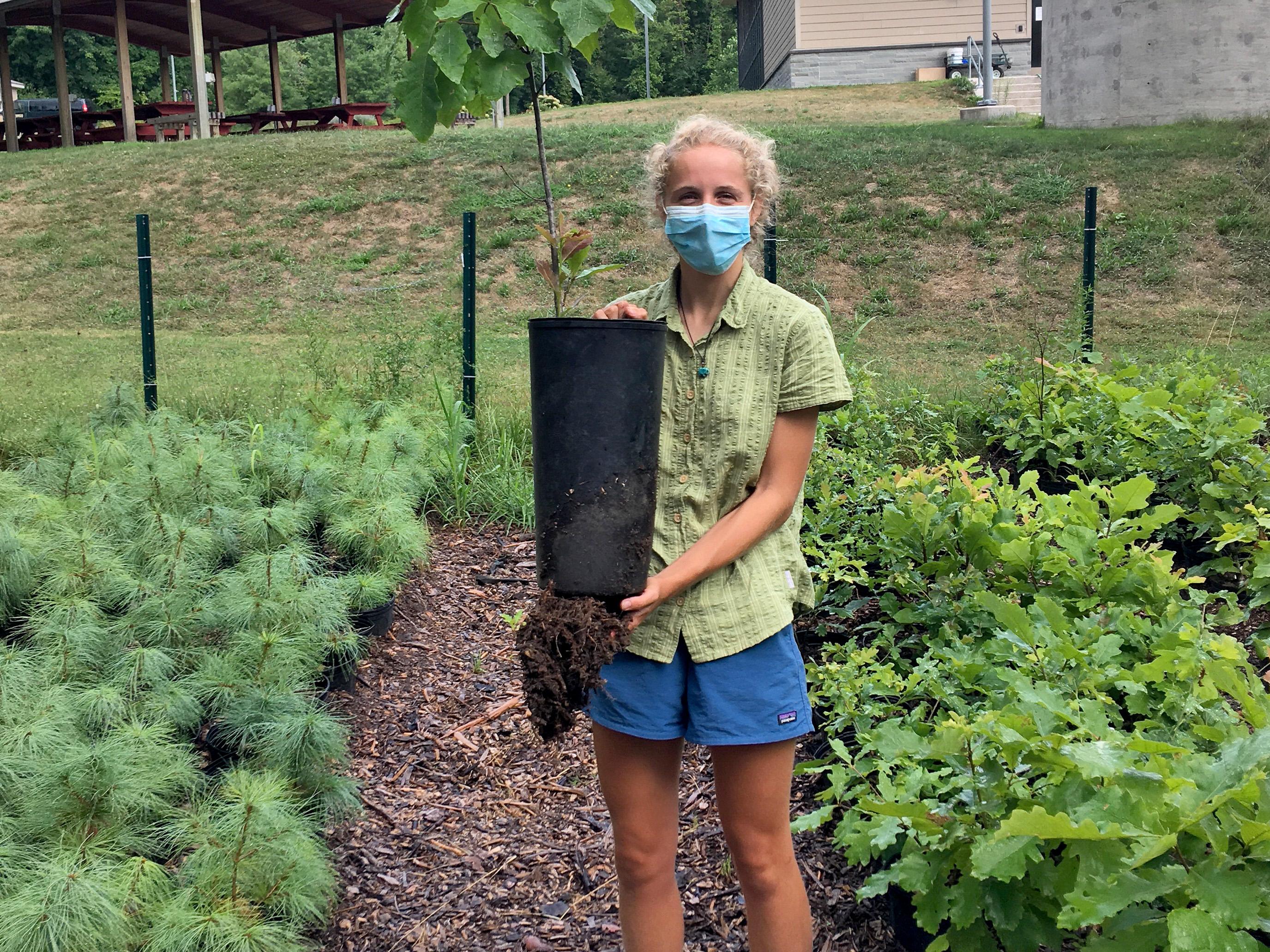Giving trees -- CFRP intern Piper Warren holding one of the project's trees.
A partnership between SUNY Oswego's Rice Creek Field Station and the Canal Forest Restoration Project (CFRP) is on a mission to restore native tree species to New York State’s canal region seeks help from the public in receiving and planting trees, as well as collecting specific seeds.
The project addresses how tree species such as white oak, swamp white oak and white pine that were disproportionately lost due to timber harvest and wetland draining to support the canal industry.
CFRP, based at Rice Creek Field, is growing trees for free distribution to the public. Once planted, these trees will provide habitat for native species, return culturally significant trees to the region, and trap and store carbon during their long lives to reduce the impacts of climate change.
To do all this, the CFRP needs help.
First, they need people to plant trees. CFRP currently has saplings available of white oak, swamp white oak, burr oak and white pine. Individuals can request up to two trees and CFRP team members will arrange for a contact-free pickup at Rice Creek Field Station, now through the end of October. For plantings in places accessible to the public, more than two trees can be requested. Anyone in the region is welcome to participate. Requests can be made on Rice Creek's CFRP website.
A second way to help is by collecting seeds or alerting CFRP of potential sites to collect. The project seeks seeds of the following species: white oak (Quercus alba), swamp white oak (Quercus bicolor), burr oak (Quercus macrocarpa), white pine (Pinus strobus) and tupelo/black gum (Nyssa sylvatica). For those unsure how to identify these species, helpful resources like the free app PlantNet that can help identify trees based on photographs of the leaves. Those who think they might have these trees can also email images to rcfs@oswego.edu for confirmation.
Seeds are best collected when they are naturally dispersing, with autumn being a great time for many species.
Here are some species-specific directions:
Oaks: Collect when the acorns are turning from green to brown and the cap can be easily removed. Best is to collect right off the trees or soon after they fall to the ground. Be gentle with acorns that already have an emerging root. A small hole in the acorn is a result of an insect (acorn weevil) and usually kills the acorn. Acorns should be packed into zip-top plastic bags along with a moist paper towel and a twig and leaf for verification of species identity. Keep acorns in the refrigerator until you can send or deliver them to Rice Creek.
Identification tips: All the oak species in the project are in the white oak group, meaning their leaves have rounded lobes, not pointy. Swamp white oak and burr oak leaves are darker green on top and fuzzy and whiter on the bottom. Non-native English oak (Quercus robur) can easily be confused with native white oak and is a common horticultural planting in this area. One distinguishing feature is the rounded, earlobe-like flaps at the base of English oak leaves, while the base of white oak leaves tapers to the stem. Note that this is a very lean year for acorns in the three target species, so the public’s help is needed more than ever to help find acorns.
White pine: Pine seeds develop under the scales of pine cones, two per scale. For the highest yield, collect cones directly from trees in mid- to late-August when they are just under-ripe and not yet open, and allow cones to dry out in a warm, sunny location for a few weeks. Harvesting cones can be accomplished with a long extension pruner. If cones are out of reach or already dropping, they can be collected from the ground. Tap cones against a hard surface to release the small winged seeds, bending scales upward to help the process. Gloves are recommended for this process, as white pine resin is quite sticky. Cones you find on the ground may only have a few seeds left. Seeds can be stored dry at room temperature and can be mailed or dropped off at Rice Creek along with a twig for verification of species identity.
Identification tip: White pine needles are grouped in bundles of five, and their long cones have white resin (hence the name).
Tupelo/black gum: Fruits are ripe when they turn blue-black. They can be collected directly from trees or off the ground. Fruits can be delivered or mailed as is to Rice Creek (along with a twig and leaf). Tupelo/black gum trees have oval-shaped glossy leaves that end in a pointy tip. The leaves turn bright shades of orange, red and purple in autumn. This tree naturally grows in moist sites but is also planted as a street tree.
Seeds can be dropped off at Rice Creek Mondays through Fridays, 9 a.m. to 4:30 p.m., at 193 Thompson Road in Oswego. Those dropping off seeds are advised to call 315-312-6678 in advance to ensure staff availability. Seeds can also be mailed to SUNY Oswego; 7060 State Route 104; Central Receiving/Attn: Rice Creek; Oswego, NY, 13126.
A third way to help is by donating empty three-gallon buckets with lids, such as empty Tidy Cats kitty litter containers. CFRP uses these for overwintering seeds in soil. Buckets can be dropped off in the same manner as seeds.
The Canal Forest Restoration Project is supported by many volunteers, partners such as Steven Frost and the New York State Nursery, donors including Dr. George and Jane Pauk, and all those who plant a tree. Visit Rice Creek's CFRP website for more information about the project including how to support it through planting, volunteering and donating.




